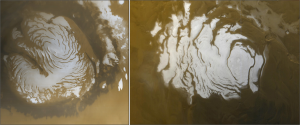The north pole (left) and south pole of Mars consist of layers of ice and dust deposited over millennia, as shown in these images from the Mars Global Surveyor spacecraft. Most of the ice is frozen water, although a layer of frozen carbon dioxide accumulates atop each cap during winter. [NASA/JPL/MSSS]
You are here
Moon and Mars
Most of Mars is fairly dark — shades of grey and orange. But it’s topped in pure white — its ice caps. They span hundreds of miles, and contain huge amounts of frozen water. And they preserve a record of the Martian climate that future scientists may plumb.
The northern cap is the bigger one — about 600 miles across. It’s not quite as thick as the southern one, but it contains more ice.
Both caps are dynamic — they wax and wane with the seasons. They consist mainly of vast amounts of frozen water, which pretty much stays in place all year long.
During winter, though, a cap is topped by a layer of frozen carbon dioxide — dry ice. That crust can range from a few feet to a couple of dozen feet thick. It’s deposited by snow-laden clouds, or it freezes directly from the atmosphere. In spring and summer, that layer vaporizes and rushes back into the air. That makes the atmosphere thicker. It also stirs up dust storms, some of which can blanket the entire planet.
The process of freezing and thawing creates layers in the ice. Dust is sandwiched between each layer. So if scientists could drill into the ice caps, they could “read” the planet’s climate history like biologists reading the rings of a tree — a history preserved in ice.
Mars teams up with the Moon the next few mornings. Tomorrow, they climb into good view by 2 or 3, with Mars close to the left of the Moon. They’ll be even closer at first light.
More about Mars and the Moon tomorrow.
Script by Damond Benningfield
Get Premium Audio
Listen to today's episode of StarDate on the web the same day it airs in high-quality streaming audio without any extra ads or announcements. Choose a $8 one-month pass, or listen every day for a year for just $30.






